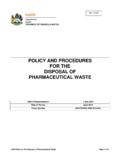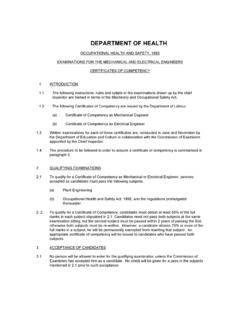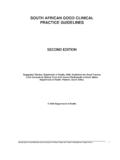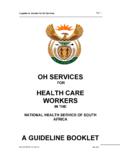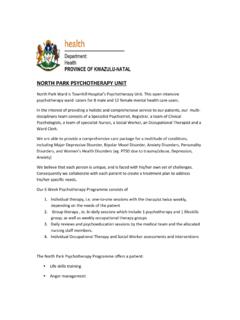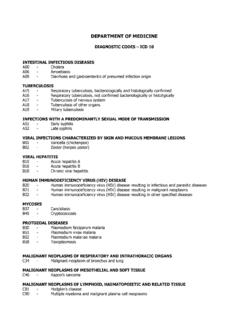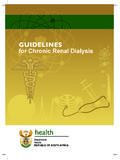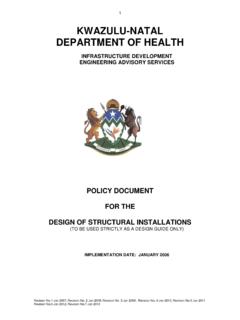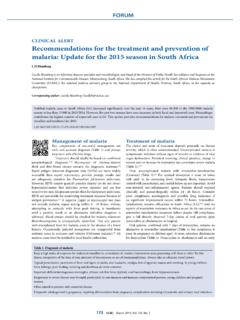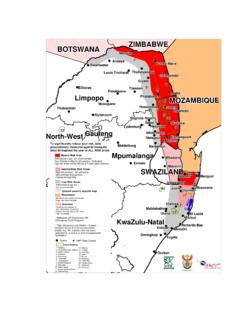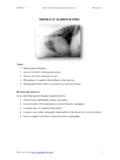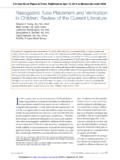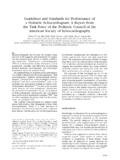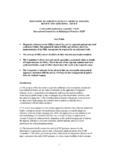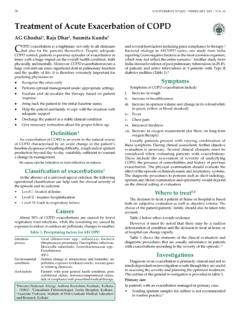Transcription of MEDICAL TREATMENT GUIDELINES - Department of Health
1 TREATMENT GUIDELINES and Policies, Department of Medicine, Edendale Hospital, Updated July 2010. 1 Department of Internal Medicine Edendale Hospital MEDICAL TREATMENT GUIDELINES Section The breathless patient 1 Respiratory emergency 2 Management of severe haemoptysis
2 3 Severe community acquired pneumonia 4 Pneumocystis pneumonia 5 Overwhelming sepsis 6 Intubation of MEDICAL patients 7 Lactic acidosis 8 Admission to the intensive care unit 9 Management of abnormal potassium levels 10
3 Management of abnormal glucose levels 11 Management of abnormal blood pressure 12 Inability to walk or frequent falls 13 Management of the acute confusional state and implementation of the mental healthcare act 14 Serious headache 15 Indications for lumber puncture and interpretation and management of CSF abnormalities 16 Booking and preparing patients for CT scan 17 Diagnosis and management of status epliepticus
4 18 Management of the unconscious patients ( Stroke Care Pack ) 19 Use of analgesics and local anaesthetics 20 Initial pharmacological management of STEMI 21 Initiating warfarin in patients with atrial fibrillation 22 Warfarin and INR GUIDELINES 23
5 Approach to severe thrombocytopaenia 24 Approach to anaemia and pancytopaenia 25 Use of blood products by MEDICAL patients 26 Approach to weight loss 27 Abdominal pain on ARVs 28 Jaundice 29 Odynophagia 30 Diarrhoea and dehydration
6 31 Vomiting 32 Renal failure 33 Prescribing fluids, feeds and medications 34 Palliative care pack 35 Tuberculosis Diagnosis and management of tuberculosis 36 Management of TB drug induced hepatitis
7 37 Transfer to Richmond Hospital 38 Algorithms MEDICAL early warning score (Triage Score) 39 Diagnosis and management of LRTI 40 WHO GUIDELINES on the diagnosis of smear-negative TB in ambulatory patients 41 WHO GUIDELINES on the diagnosis of smear-negative TB in seriously ill patients 42 Algorithm for the management of aggressive and agitated patients 43 Algorithm for management of status epilepticus 44 Management of prolonged INR 45
8 Warfarin dose adjustment algorithms 46 Renal dosing of antiretroviral drugs 47 Note: These GUIDELINES are intended for use by staff in the Department of Medicine, EDH. Please email with comments and suggestions. TREATMENT GUIDELINES and Policies, Department of Medicine, Edendale Hospital, Updated July 2010. 2 Section 1 APPROACH TO THE BREATHLESS PATIENT Causes of breathlessness: 1.
9 Pulmonary oedema 2. Status asthmaticus 3. Pneumonia, including atypical and Pneumocystis pneumonia 4. Infective exacerbation of COPD / bronchiectasis 5. Systemic inflammatory response syndrome (usually caused by sepsis) 6. Aspiration 7. Tension pneumothorax or massive pleural effusion 8. Pulmonary embolus 9. Pericardial tamponade 10. Anaemia 11. Acidosis - DKA / Renal failure / Lactic acidosis (d4T / ddI) 12. Hyper-ventilation (conversional disorder) Causes of dyspnoea with a raised jugular venous pressure: Cardiogenic pulmonary oedema Cor pulmonale with infective exacerbation Pulmonary embolus Pericardial tamponade Renal failure with fluid overload (pulmonary oedema and / or metabolic acidosis) Have a low threshold for cardiac ultrasound to rule out pericardial effusion (aspiration is easy and effective) Initial management.
10 Measure oxygen saturations in room air Oxygen by face mask - rapidly escalate to re-breather (FiO2 ~70%) Heart rate / respiratory rate / temperature / blood pressure Listen to chest Crackles / wheeze / decreased breath sounds / bronchial breathing If wheezing or silent chest - give nebulised beta 2 agonist and IV corticosteroids IV access use external jugular if necessary - take blood culture Ceftriaxone or co-amoxiclav IV stat Initial diagnostic work-up: chest radiograph Pulmonary oedema Pneumothorax Pneumonia Pleural effusion Arterial blood gases and acid / base Document the inspired O2 and guesstimate the A-a gradient (%FiO2 PO2) Type 1 or Type 2 failure?
